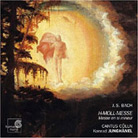June 2004
 Though some mystery surrounds the origin of Bach’s only
large-scale mass for singers and instruments, there is a universal judgment that it is one
of the greatest works of its nature in the catalog. The brief but reasonably comprehensive
notes included in this set’s booklet give a plausible history and explanation of the
work’s composition. Though some mystery surrounds the origin of Bach’s only
large-scale mass for singers and instruments, there is a universal judgment that it is one
of the greatest works of its nature in the catalog. The brief but reasonably comprehensive
notes included in this set’s booklet give a plausible history and explanation of the
work’s composition.
Though the composition has been a staple of choral societies and better church choirs for years, it has become fashionable over the past ten years to perform it with solo voices. Most of these efforts have sounded anemic and undernourished to me, the end not justifying the means. Not so with this virile reading. In this recording, the B Minor Mass is sung one voice to a part except the "Kyrie eleison," "Cum Sancto Spiritu," and "Dona Nobis Pacem," where the SSATB scoring is doubled. Soloists are drawn from the ensemble, or you might reverse that and say that soloists become the ensemble during larger moments. Instrumental lines are also handled by single players, so when all is said and done, the total number of performers stands at four sopranos, two altos, two tenors, two basses, three violins, one viola, one cello, one bass, two flutes, three oboes, two bassoons, one horn, three trumpets, timpani, and organ. Every singer and player is a thorough professional with enviable technique. There are no weak links. They sing and play with precision, passion, and joy. Given the smaller forces, faster tempos are possible and contrapuntal sections are amazingly crisp and clean. Energy and excitement make up what might be lost in the grandeur of a full chorus and orchestra performance. My favorite section, the "Quoniam tu solus sanctus," scored for bass, horn, two bassoons, and continuo, receives a definitive performance from Wolf-Matthias-Friedrich, Ulrich Hübner, Adrian Rovatkay, Christian Walter, Albert Brüggen, Mathias Müller-Mohr, and Carsten Lohff. How wonderful to hear a real bass, not baritone, sing this section! The recording was produced and engineered by Andreas Neubronner and Peter Lenger, the team that Michael Tilson Thomas insists upon for his great-sounding San Francisco Symphony recordings. It proves here that it can work wonders on the other side of the Atlantic. The warm acoustic of the St. Osdag Church in Neustadt-Mandelsloh seems 100% right. The recording is close up for the best seat in the house, yet one has a good sense of space around the instruments and behind the listener, thanks to adroit use of the multichannel format. The stereo tracks are robust and clean, with less sense of space. The CD tracks sound flat and lifeless when directly compared to either SACD effort. A handsome presentation box and booklet appropriately house this jewel of a recording. GO BACK TO: |
 Bach - B Minor Mass
Bach - B Minor Mass